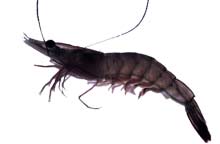Marine - Species
White Shrimp (Litopenaeus setiferus)
General Description
Light gray to whitish; no grooves at base of rostrum or along the head; long, thin rostrum; dark brown antennae 2x-3x longer than body. Uropods with a dark base and yellow-green edges.
Average Size
4 – 6 inches;
South Carolina maximum size: approx. 10 inches;
maximum age: approx. 2 years
Habitat
Adults: Inhabit estuarine waters, typically over muddy bottoms and in habitats with high detritus loads; move to offshore mud bottom habitats during and following spawning.
Juveniles: Utilize tidal creeks, oyster reefs and estuaries, typically over muddy bottoms; move closer to estuary mouths as growth continues.
Reproductive Cycle
- Adults mature between April and June of their first year. Approx. size at maturity: males – 6.1 inches, females – 5.3 inches.
- Migrate to nearshore coastal areas with muddy bottoms for summer spawning.
- Post-larvae believed to use nearshore tidal and wind-driven currents to move into estuaries during spring and summer. Utilize shallow, muddy tidal creeks with low to moderate salinity as nursery grounds; migrate to deeper reaches of estuaries as juveniles.
Foraging Habits
- All sizes of white shrimp are opportunistic bottom-feeders. Adults and juveniles typically feed at night.
- Adults: Actively prey upon marine worms, larvae of other crustaceans, and small fishes; also consume plant and animal detritus; may cannibalize other white shrimp, especially at higher population densities.
- Juveniles: Diet includes small benthic worms, plant matter, fish and invertebrate fecal pellets, and decaying animals. Larval stages consume zooplankton and phytoplankton.
Availability/Vulnerability to Harvest
- Distribution and abundance correlated with temperature. Low temperatures slow growth, delay maturity, and may kill stocks overwintering in estuaries. Migration to spawning habitats and recruitment to commercial fisheries occur later following colder winters. Southward migrations in coastal waters may also occur during winter months; return migration northward with warming water.
- Distribution and abundance also related to salinity. All life stages apparently tolerate wide salinity ranges; however, localized movement into deeper water occurs after heavy rainfall. Larvae prefer low salinity waters; juveniles are most abundant at intermediate salinities (7 – 15 ppt), and adults to high salinity offshore water.
- Conservation concerns: degradation or loss of estuarine habitat vital to postlarvae and juveniles; alteration of freshwater runoff and variations in salinity due to upstream land use; pollution and compromised water quality; lack of understanding of disease prevalence; potentially high commercial and recreational fishing pressure – offshore abundance generally greatest within 5 miles of coast.
Literature Cited
Delancey LB, JE Jenkins, MB Maddox, JD Whitaker, EL Wenner. 2005. Field observations on white shrimp, Litopenaeus setiferus, during spring spawning season in South Carolina, U.S.A., 1980-2003. J Crust Biol 25: 212-218.
Muncy RJ. 1984. Species profiles: life histories and environmental requirements of coastal fishes and invertebrates (South Atlantic) – white shrimp. U.S. Fish Wildl Serv FWS/OBS-82/11.27. U.S. Army Corps of Engineers, TR EL-82-4. 19 pp. Accessed: September, 2009.
Perez-Farfante I. 1969. Western Atlantic shrimps of the genus Penaeus. Fish Bull 67: 461-591.
U.S.N.M.F.S. 1981. Profile of the Penaeid shrimp fishery in the South Atlantic. South Atlantic Fishery Management Council. 321pp.
Wenner E, D Knott, J Blanton, C Barans. 1998. Roles of tidal and wind-generated currents in transporting white shrimp (Penaeus setiferus) postlarve through a South Carolina (USA) inlet. J Plank Res 20: 2333-2356.


